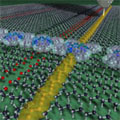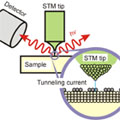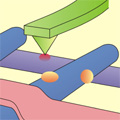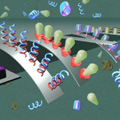

 Single-molecule electronics has long been expected to compete with silicon-based
electronics and many efforts have been made. However, it is still impossible
to fabricate a practical single-molecule integrated circuit, largely because
of the lack of good methods for wiring each molecule. Several years ago,
we developed a method for fabricating single conductive polymer chains
at designated positions by using the probe tip of a scanning tunneling
microscope (STM) to initiate chain polymerization. Using this method, we
are carrying out further studies for connecting single conductive polymers
to single functional molecules and other functional materials. Fabrication
and characterization of such structures will enable us to fabricate novel
molecular nano-systems which have excellent functions.
Single-molecule electronics has long been expected to compete with silicon-based
electronics and many efforts have been made. However, it is still impossible
to fabricate a practical single-molecule integrated circuit, largely because
of the lack of good methods for wiring each molecule. Several years ago,
we developed a method for fabricating single conductive polymer chains
at designated positions by using the probe tip of a scanning tunneling
microscope (STM) to initiate chain polymerization. Using this method, we
are carrying out further studies for connecting single conductive polymers
to single functional molecules and other functional materials. Fabrication
and characterization of such structures will enable us to fabricate novel
molecular nano-systems which have excellent functions. |
 Scanning tunneling microscope (STM) tip is used as a tunneling electron
source with the high spatial resolution. Light is created as a result of
inelastic scattering of the electrons. The light includes unique information
about light creation process in the tunneling gap and light propagation
process from the gap to a far-field distance. The energy of the light is
related to energy level of the surface states relevant to the tunnneling.
The linearly polarized light includes information about orbital symmetry
of the surface state. The circularly polarized light contains spin information.
Scanning tunneling microscope (STM) tip is used as a tunneling electron
source with the high spatial resolution. Light is created as a result of
inelastic scattering of the electrons. The light includes unique information
about light creation process in the tunneling gap and light propagation
process from the gap to a far-field distance. The energy of the light is
related to energy level of the surface states relevant to the tunnneling.
The linearly polarized light includes information about orbital symmetry
of the surface state. The circularly polarized light contains spin information. |
 Oxide and semiconductor nanowires are promising tools in future opto-
and spin-electronics. We fabricate unique nanowires and nanostructures
and arrange individual nanostructure into desired arrangements to achieve
novel functionality. We develop the scanning probe microscope (SPM)-based
technique to measure local electrical, optical, and magnetic properties
of individual nanostructures. Based on the understanding of their local
properties, we design nanoscale arrangement and study mutual linkage of
individual nanostructure. Oxide and semiconductor nanowires are promising tools in future opto-
and spin-electronics. We fabricate unique nanowires and nanostructures
and arrange individual nanostructure into desired arrangements to achieve
novel functionality. We develop the scanning probe microscope (SPM)-based
technique to measure local electrical, optical, and magnetic properties
of individual nanostructures. Based on the understanding of their local
properties, we design nanoscale arrangement and study mutual linkage of
individual nanostructure. |
 Biomacromolecules including proteins are functional at the molecular level.
These molecules are excellent functional nanomaterials in nature. Biomaterials
and biomolecules are studied as nano-machines in our group in order to
unravel the mechanism of them, which is a different approach from conventional
biochemistry and molecular-biology. We will develop practicable nanotechnology
for biomaterials that is required for the new period of post-genome and
post-proteome days. Application of the technology will start in medical,
pharmaceutical and physiological fields as examination, evaluation and
development techniques, and will open a way to develop novel nanodevice
based on biomolecules. Biomacromolecules including proteins are functional at the molecular level.
These molecules are excellent functional nanomaterials in nature. Biomaterials
and biomolecules are studied as nano-machines in our group in order to
unravel the mechanism of them, which is a different approach from conventional
biochemistry and molecular-biology. We will develop practicable nanotechnology
for biomaterials that is required for the new period of post-genome and
post-proteome days. Application of the technology will start in medical,
pharmaceutical and physiological fields as examination, evaluation and
development techniques, and will open a way to develop novel nanodevice
based on biomolecules. |
 Microfabricated cantilever arrays are emerging as label-free and real-time
sensors for detecting tiny amount of various target molecules in parallel.
Adsorption of analytes on a receptor layer coated on a cantilever surface
induces surface stress, which makes the cantilever bend. This simple mechanics
opened a myriad of possibilities for the use of atomic force microscopy
(AFM) cantilever deflection technique beyond imaging. Applications ranging
from chemistry to genomics have been demonstrated, for example, detection
of volatile organic compounds, triggered marker genes, viruses, fungi,
etc. In contrast to conventional optical (laser) read-out technique for
the measurement of cantilever deflection, piezoresistive read-out system
does not require bulky and expensive instrumentation. This approach contains
various advantages, such as low cost, simple operation, miniaturization
for fully integrated devices, and measurements in opaque liquid including
blood. Geometrical optimization will lead to significant improvement of
the sensitivity, lifting piezoresistive detection onto the same level of
sensitivity as general optical methods in use, or even higher. It will
open the door to a new era of medical diagnostic as well as genetic and
environmental researches in the near future.
Microfabricated cantilever arrays are emerging as label-free and real-time
sensors for detecting tiny amount of various target molecules in parallel.
Adsorption of analytes on a receptor layer coated on a cantilever surface
induces surface stress, which makes the cantilever bend. This simple mechanics
opened a myriad of possibilities for the use of atomic force microscopy
(AFM) cantilever deflection technique beyond imaging. Applications ranging
from chemistry to genomics have been demonstrated, for example, detection
of volatile organic compounds, triggered marker genes, viruses, fungi,
etc. In contrast to conventional optical (laser) read-out technique for
the measurement of cantilever deflection, piezoresistive read-out system
does not require bulky and expensive instrumentation. This approach contains
various advantages, such as low cost, simple operation, miniaturization
for fully integrated devices, and measurements in opaque liquid including
blood. Geometrical optimization will lead to significant improvement of
the sensitivity, lifting piezoresistive detection onto the same level of
sensitivity as general optical methods in use, or even higher. It will
open the door to a new era of medical diagnostic as well as genetic and
environmental researches in the near future. |
